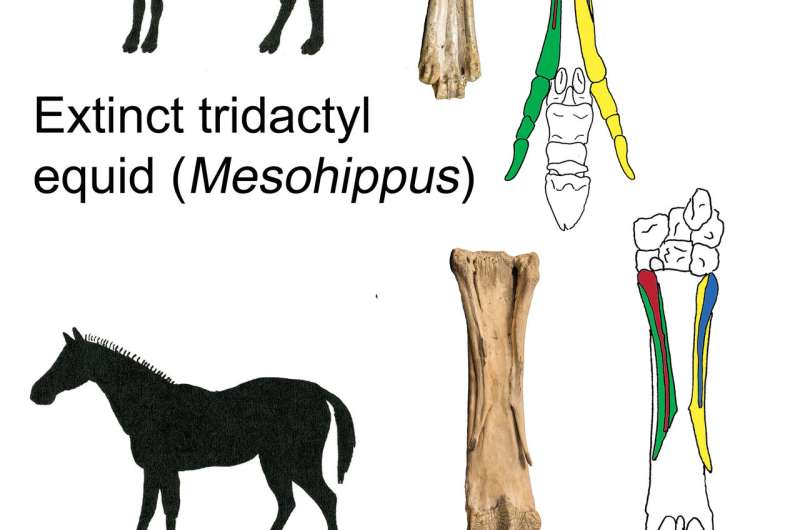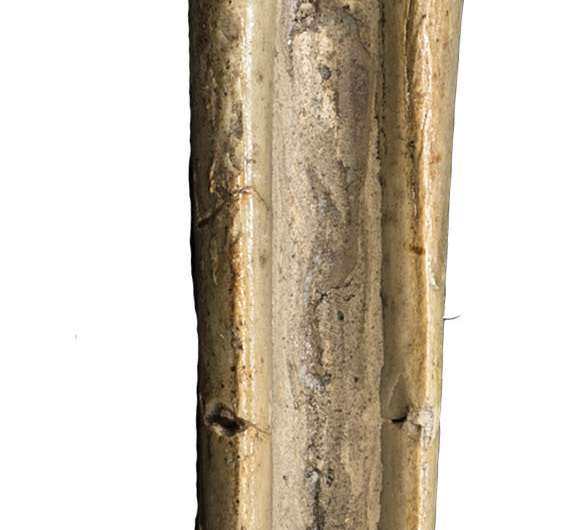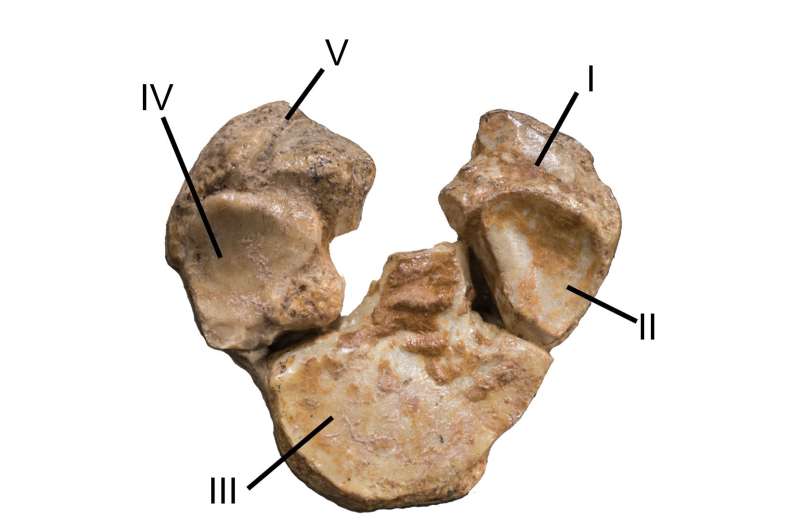Silhouettes show Mesohippus primigenium, an early ancestor of the modern horse that lived 40 million years ago and was previously believed to have three toes, and the modern horse. Photographs of both animals' hand bones appear alongside renderings of the researchers' proposed digit identities. The researchers argue that missing digits one and five are partially expressed on the surfaces of the side toes (shown in red/blue). While the horse is described as being monodactyl, with only one complete digit, the researchers demonstrate that digits two and four are expressed as the splint bones and frog (padding of the foot), as shown in yellow/green. Missing digits one and five are expressed as ridges on the splint bones and as the hoof cartilages, as shown in the lower red/blue areas. Credit: NYITCOM
Seabiscuit, Secretariat and every nag to ever pull a plough had five toes on each foot, says a study released Wednesday that stomps on the notion modern horses only have one toe.
Scientists have long assumed that horses, zebras and other equines gradually lost their digits over millions of years of evolution until all that was left—uniquely among mammals—was a great big middle toe ending in a hoof.
That assumption is at least partially wrong, according to the study, published in the journal Royal Society Open Science.
"We provide evidence that the 'missing' digits are in fact still present," lead author Nikos Solounias, a professor at the New York Institute of Technology, told AFP.
"All five digits have merged to form the compact forelimb with hooves we know today," he said, comparing it to a tulip that never opens.
The phantom fingers are not visible to the naked eye, but an examination of bones, fossils, and arteries in embryos revealed traces of the toes thought to have vanished over time, he told AFP.
Scientists agree that humans, horses and other mammals are descendants of a common, distant ancestor with five fingers per limb.
But when subtropical forests gave way some 35 million years ago to savannahs with hard compact ground, the anatomy of squat, three- and four-toed horses adapted.
"Hooves and long legs helped horses run farther and faster on the open prairie, helping them flee predators and find fresh grass for grazing," the American Museum of Natural History explained.
Back view of 40 million-year-old Mesohippus' metacarpal. While three fully formed toes are visible, the researchers contend that ridges on the side of the toes represent the two missing digits, and that therefore, all 5 digits are expressed. Credit: NYITCOM
By about nine million years ago, equine forest browsers had mostly given way to grass-eating grazers whose central digit had changed into a long bone above the hoof, known as the metacarpal.
Some scientists acknowledge that small splints on the outer edges of the metacarpal in modern horses are remnants of the second and fourth digits, but argue that the equivalent of the little toe and thumb—digits #1 and #5—have entirely disappeared.
But a closer look at bone structure in modern horses revealed ridges on the back of the splints corresponding to these outer-most toes, the study argued.
Bottom of fossilized forelimb with five surfaces of differing texture, which suggests five digits are still present on today's horse. Credit: NYITCOM
The researchers also traced the gradual metamorphosis of equine limbs over 55 million years of evolution, showing that the digits had merged.
Even more revealing, dissections of foetal and adult horses uncovered a neurovascular network consistent with five digits, not one.
"If there are five fingers, there should be 10 primary nerves and 10 arteries—exactly what we found," Solounias said.
"We are suggesting a new paradigm where horse limb evolution is formed by re-shaping, not by loss," said Solounias.
More information: The evolution and anatomy of the horse manus with an emphasis on digit reduction, Royal Society Open Science, rsos.royalsocietypublishing.or … /10.1098/rsos.171782
Journal information: Royal Society Open Science
© 2018 AFP























